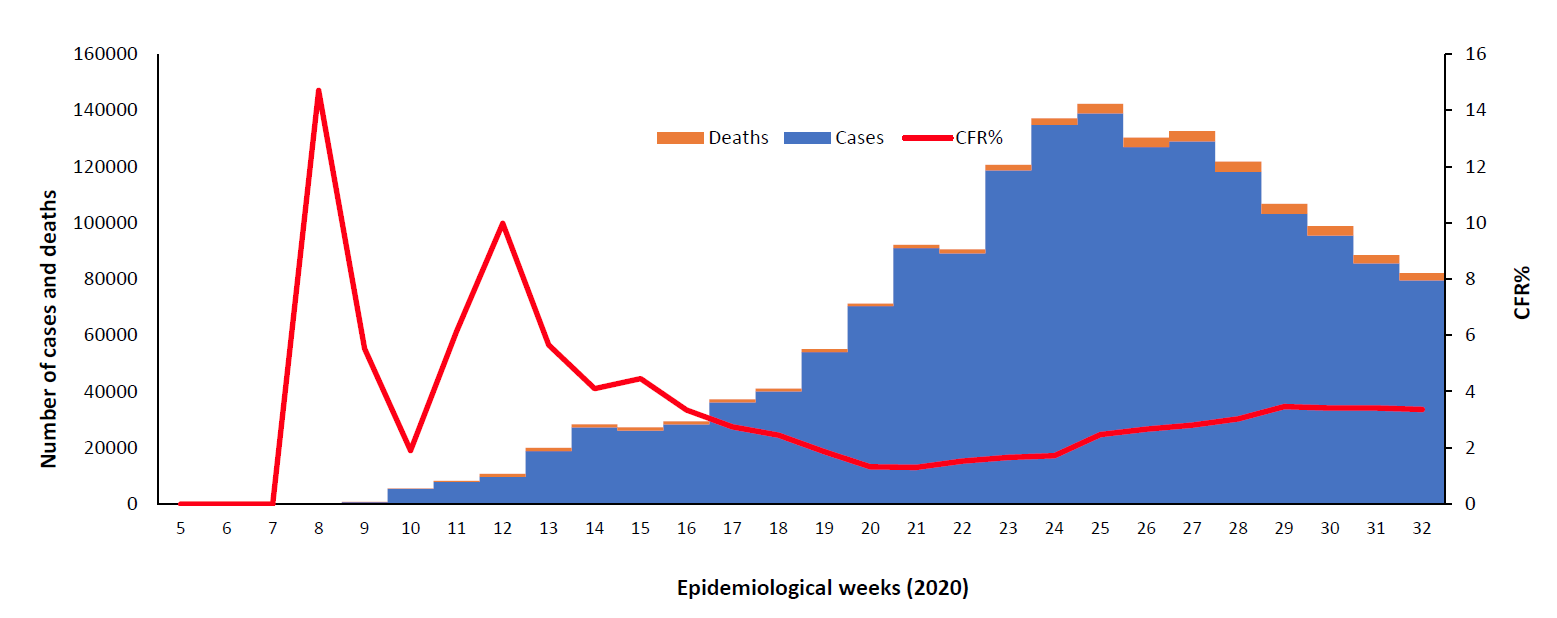The coronavirus disease COVID-19 has been spreading for the past 6 months, and it continues to accelerate at regional and global levels. As of 8 August 2020, 19 187 943 cases and 716 075 associated deaths with a case-fatality rate (CFR) of 3.7% have been reported globally. The 22 countries of the Eastern Mediterranean Region (EMR) have reported a total of 1 634 940 cases so far, which represent about 8.5% of the global count, with 43 080 associated deaths (CFR 2.6%). Most countries in the Region are in the community transmission phase.
Since the beginning of the outbreak, the country that has reported the highest number of total cases in the Region is Islamic Republic of Iran (324 692 cases; 19.9% of the Region’s total), followed by Saudi Arabia (287 262; 17.6%) and Pakistan (284 103; 17.4%). Islamic Republic of Iran also reported the highest number of total associated deaths (18 264; CFR 5.6%) followed by Pakistan (6074; CFR 2.1%) and Egypt (4992; CFR 5.2%). The highest CFR was reported from Yemen (28.5%) followed by Sudan (6.5%), while the lowest CFR was reported from Qatar (0.2%) followed by Bahrain (0.4%).
During epidemiological week 32, the Region reported a 7.2% decrease when compared to the cases reported during the previous week (79 481 cases compared to 85 636 cases). An 8.8% reduction was observed for associated deaths as well (2670 deaths compared to 2928 deaths). On the other hand, the weekly trend per capita showed stabilization as compared to the previous week (223.7 compared to 212.8/100 000).
In week 32, Libya, Syria and Lebanon reported relative increase in COVID-19 activity. The number of cases in Libya increased from 3691 to 5078 (38% increase compared to the previous week), Syria 780 to 1060 (36% increase) and Lebanon 4730 to 5951 (26% increase). Libya, Morocco and Oman had the largest relative increase in deaths (35%, 26% and 21%, respectively).
In terms of testing, a total of 20 827 456 laboratory PCR tests were conducted since the start of the outbreak across the Region including 1 470 245 tests in week 32, which showed an 8% decrease as compared to the tests performed in the previous week (1 600 662). The highest number of PCR tests were reported from United Arab Emirates (5.4 million), followed by Saudi Arabia (3.7 million) and Islamic Republic of Iran (2.6 million). The United Arab Emirates and Bahrain are performing the highest rate of testing per capita (54 994/100 000 and 52 476/100 000, respectively). The average positivity rate for the Region is 7.8%. WHO recommends a positivity rate of around 3–12% as a general benchmark indicating adequate testing, which was achieved in most countries of the Region.
The regional incident management support team continues to coordinate the response and provide technical support to countries and partners in the Region in the areas of coordination and partnership, surveillance, laboratory capacity, clinical management, infection prevention and control, risk communication, points of entry according to the International Health Regulations (2005), research, health system, essential health services and others. For improving laboratory capacity, 30 labs from EMR participated in the Global EQAP (WHO External Quality Assessment Project) for COVID-19. Out of 28 labs that received the panels, 25 labs scored 5 out of 5; 2 labs scored 4 out of 5; and 1 lab scored 0 out of 5 (reporting error). EMRO has started working closely with the labs that did not score 100% to improve and strengthen their capacities in the areas that have been identified as problematic.
Yemen surge mission is still underway to improve clinical case management. Coordination with Jordan to develop a tailored COVID-19 management course for doctors and nurses took place, and coordination with Afghanistan to facilitate training for critical care practitioners in rural areas was initiated.
A regional training for communication professionals on informed coverage and responsible reporting was conducted jointly by UNESCO, the American University in Cairo, and EMRO.
In Reproductive, Maternal, Newborn, Child and Adolescent Health, WHO continued to develop tools and templates on mitigating the effects of COVID-19 in Pakistan, Susan and Yemen. It also followed up on the prioritization of an reproductive and maternal health plan of activities for 2020 implementation in Egypt, Lebanon, Morocco and Tunisia. UNICEFand UNFPA joined WHO to discuss the agenda for the virtual meeting with ministers of health on continuation of essential services for this area of work in the context of COVID-19.

For more data from the Region, please visit the COVID-19 dashboard.
Subscribe to the monthly infectious hazard preparedness newsletter of WHO’s Health Emergencies Programme for latest data and analysis on epidemic- and pandemic-prone diseases, as well as news on outbreak preparedness and response within WHO’s Eastern Mediterranean Region.








